Adiabatic Cooling System Working Process Investigation
Abstract
:1. Introduction
2. Materials and Methods
- Tm—average air temperature, °C;
- RHm—average relative humidity of air, %.
- TW—thermodynamic wet-bulb temperature of entering air °C.
- n1—the number of animals in a shed, heads (pieces);
- q1—the amount of moisture released by one head, kg/h;
- k—a coefficient of performance of a cooling system;
- n2—the number of fans equipped with nozzles;
- q2—water consumption by the nozzles of one fan, kg/h;
- ρ1—density of an incoming air kg/m3;
- d1—humidity of an incoming air, kg/kg;
- d2—humidity of the air in a cowshed, kg/kg.
3. Results and Discussion
4. Conclusions
5. Recommendations and Prognosis
Author Contributions
Funding
Institutional Review Board Statement
Informed Consent Statement
Data Availability Statement
Conflicts of Interest
References
- Polsky, L.; von Keyserlingk, M.A.G. Invited review: Effects of heat stress on dairy cattle welfare. J. Dairy Sci. 2017, 100, 8645–8657. [Google Scholar] [CrossRef] [Green Version]
- Ferreira, F.; Gennari, R.; Dahl, G.; De Vries, A. Economic feasibility of cooling dry cows across the United States. J. Dairy Sci. 2016, 99, 9931–9941. [Google Scholar] [CrossRef] [Green Version]
- Mylostyvyi, R.; Chernenko, O. Correlations between Environmental Factors and Milk Production of Holstein Cows. Data 2019, 4, 103. [Google Scholar] [CrossRef] [Green Version]
- Bleizgys, R.; Naujokienė, V.; Čėsna, J. Humidification–Cooling System in Semi-Insulated Box-Type Cowsheds Prevent the Loss of Milk Productivity Due to Thermal Stress. Agronomy 2022, 12, 1131. [Google Scholar] [CrossRef]
- Aggarwal, A.; Upadhyay, R. Shelter Management for Alleviation of Heat Stress in Cows and Buffaloes. Heat Stress Anim. Product. 2013, 169–183. [Google Scholar] [CrossRef]
- Renaudeau, D.; Collin, A.; Yahav, S.; de Basilio, V.J.; Gourdine, L.; Collier, R.J. Adaptation to hot climate and strategies to alleviate heat stress in livestock production. Animal 2012, 6, 707–728. [Google Scholar] [CrossRef] [PubMed] [Green Version]
- Kic, P. Influence of External Thermal Conditions on Temperature–Humidity Parameters of Indoor Air in a Czech Dairy Farm during the Summer. Animals 2022, 12, 1895. [Google Scholar] [CrossRef]
- Ji, B.; Banhazi, T.; Perano, K.; Ghahramani, A.; Bowtell, L.; Wang, C.; Li, B. A review of measuring, assessing and mitigating heat stress in dairy cattle. Biosyst. Eng. 2020, 199, 4–26. [Google Scholar] [CrossRef]
- Velayudhan, S.M.; Brügemann, K.; Alam, S.; Yin, T.; Devaraj, C.; Sejian, V.; Schlecht, E.; König, S. Molecular, Physiological and Hematological Responses of Crossbred Dairy Cattle in a Tropical Savanna Climate. Biology 2023, 12, 26. [Google Scholar] [CrossRef]
- Chamberlain, A.T.; Powell, C.D.; Arcier, E.; Aldenhoven, N. The relationship between on-farm environmental conditions inside and outside cow sheds during the summer in England: Can Temperature Humidity Index be predicted from outside conditions? Anim.—Open Space 2022, 1, 100019. [Google Scholar] [CrossRef]
- Armstrong, D.V. Heat stress interaction with shade and cooling. J. Dairy Sci. 1994, 77, 2044–2050. [Google Scholar] [CrossRef]
- Zimbelman, R.B.; Collier, R.J.; Eastridge, M.L. Feeding strategies for high-producing dairy cows during periods of elevated heat and humidity. In Proceedings of the 20th Annual Tri-State Dairy Nutrition Conference, Ft. Wayne, IN, USA, 19–20 April 2011; pp. 111–125. [Google Scholar]
- Levit, H.; Pinto, S.; Amon, T.; Gershon, E.; Kleinjan-Elazary, A.; Bloch, V.; Ben Meir, Y.A.; Portnik, Y.; Jacoby, S.; Arnin, A.; et al. Dynamic cooling strategy based on individual animal response mitigated heat stress in dairy cows. Animal 2021, 15, 100093. [Google Scholar] [CrossRef]
- Broucek, J.; Novak, P.; Vokralova, J.; Soch, M.; Kisac, P.; Uhrinca, M. Effect of high temperature on milk production of cows from free-stall housing with natural ventilation. Slovak J. Anim Sci. 2009, 42, 167–173. [Google Scholar]
- Bohmanova, J.; Misztal, I.; Cole, J.B. Temperature-humidity indices as indicators of milk production losses due to heat stress. J. Dairy Sci. 2007, 90, 1947–1956. [Google Scholar] [CrossRef]
- Almuhanna, E.A.; Gamea, G.R.; Osman, O.E.; Almahdi, F.M. Performance of roof-mounted misting fans to regulate heat stress in dairy cows. J. Therm. Biol. 2021, 99, 102984. [Google Scholar] [CrossRef]
- Tresoldi, G.; Schütz, K.E.; Tucker, C.B. Cooling cows with sprinklers: Effects of soaker flow rate and timing on behavioral and physiological responses to heat load and production. J. Dairy Sci. 2019, 102, 528–538. [Google Scholar] [CrossRef] [Green Version]
- Lin, J.C.; Moss, B.R.; Koon, J.L.; Flood, C.A.; Smith, R.C., III; Cummins, K.A.; Coleman, D.A. Comparison of various fan, sprinkler, and mister systems in reducing heat stress in dairy cows. Appl. Eng. Agric. 1998, 14, 177–182. [Google Scholar] [CrossRef]
- Ashrae, A. Handbook of Fundamentals; American Society of Heating Refrigerating and Air Conditioning Engineers: Atlanta, GA, USA, 2013. [Google Scholar]
- Fournel, S.; Ouellet, V.; Charbonneau, É. Practices for Alleviating Heat Stress of Dairy Cows in Humid Continental Climates: A Literature Review. Animals 2017, 7, 37. [Google Scholar] [CrossRef] [Green Version]
- Tresoldi, G.; Schütz, K.E.; Tucker, C.B. Cooling cows with sprinklers: Spray duration affects physiological responses to heat load. J. Dairy Sci. 2018, 101, 4412–4423. [Google Scholar] [CrossRef] [Green Version]
- Anderson, S.D.; Bradford, B.J.; Harner, J.P.; Tucker, C.B.; Choi, C.Y.; Allen, J.D.; Hall, L.W.; Rungruang, S.; Collier, R.J.; Smith, J.F. Effects of adjustable and stationary fans with misters on core body temperature and lying behavior of lactating dairy cows in a semiarid climate. J. Dairy Sci. 2013, 96, 4738–4750. [Google Scholar] [CrossRef]
- Firfiris, V.K.; Martzopoulou, A.G.; Kotsopoulos, T.A. Passive cooling systems in livestock buildings towards energy saving: A critical review. Energy Build. 2019, 202, 109368. [Google Scholar] [CrossRef]
- Avendaño-Reyes, L.; Álvarez-Valenzuela, F.D.; Correa-Calderón, A.; Algándar-Sandoval, A.; Rodríguez-González, E.; Pérez-Velázquez, R.; Macías-Cruz, U.; Díaz-Molina, R.; Robinson, P.H.; Fadel, J.G. Comparison of three cooling management systems to reduce heat stress in lactating Holstein cows during hot and dry ambient conditions. Livest. Sci. 2010, 132, 48–52. [Google Scholar] [CrossRef]
- Drwencke, A.M.; Tresoldi, G.; Stevens, M.M.; Narayanan, V.; Carrazco, A.V.; Mitloehner, F.M.; Pistochini, T.E.; Tucker, C.B. Innovative cooling strategies: Dairy cow responses and water and energy use. J. Dairy Sci. 2020, 103, 5440–5454. [Google Scholar] [CrossRef]
- Our Dairy Farm Ventilation and Cooling Systems. Available online: https://www.abbi-aerotech.com/dairy-solutions/fans/ (accessed on 23 January 2023).
- PeakTech P5185. Available online: https://www.peaktech.de/PeakTech-P-5185-USB-Datenlogger-Lufttemperatur-und-feuchtigkeit-32000-Punkte/P-5185 (accessed on 23 January 2023).
- Howell, R.H.; Coad, W.J.; Sauer, H.J., Jr. Principles of Heating, Ventilating and Air-Conditioning, 7th ed.; American Society of Heating, Refrigerating and Air-Conditioning Engineers: Atlanta, GA, USA, 2013; ISBN 978-1-936504-57-2. [Google Scholar]
- Hellickson, M.A.; Walker, J.N. Ventilation of Agricultural Structures; American Society of Agricultural Engineers: St Joseph, MI, USA, 1983; 372p, ISBN 09-161-50569. [Google Scholar]
- Teye, F.K.; Hautala, M. Measuring Ventilation Rates in Dairy Buildings. Int. J. Vent. 2007, 6, 247–256. [Google Scholar] [CrossRef]
- Sallvik, K. CIGR Handbook of Agricultural Engineering, Volume II Animal Production & Aquacultural Engineering, PART I Livestock Housing and Environment, Chapter 2 Environment for Animals, Part 2.1 Animal Environment Requirements; American Society of Agricultural and Biological Engineers: St Joseph, MI, USA, 1999; pp. 31–41. [Google Scholar] [CrossRef]
- Mihai, V.; Rusu, L. Improving the Ventilation of Machinery Spaces with Direct Adiabatic Cooling System. Inventions 2022, 7, 78. [Google Scholar] [CrossRef]
- Jo, M.-S.; Shin, J.-H.; Kim, W.-J.; Jeong, J.-W. Energy-Saving Benefits of Adiabatic Humidification in the Air Conditioning Systems of Semiconductor Cleanrooms. Energies 2017, 10, 1774. [Google Scholar] [CrossRef] [Green Version]
- Bleizgys, R.; Bagdoniene, I. Control of ammonia air pollution through the management of thermal processes in cowsheds. Sci. Total Environ. 2016, 568, 990–997. [Google Scholar] [CrossRef]
- Kavolėlis, B.; Bleizgys, R.; Čėsna, J. Emission of water vapour in uninsulated cowshed. Ann. Anim. Sci. 2010, 10, 57–65. [Google Scholar]
- Samer, M.; Ammon, C.; Loebsin, C.; Fiedler, M.; Berg, W.; Sanftleben, P.; Brunsch, R. Moisture balance and tracer gas technique for ventilation rates measurement and greenhouse gases and ammonia emissions quantification in naturally ventilated buildings. Build. Environ. 2012, 50, 10–20. [Google Scholar] [CrossRef]



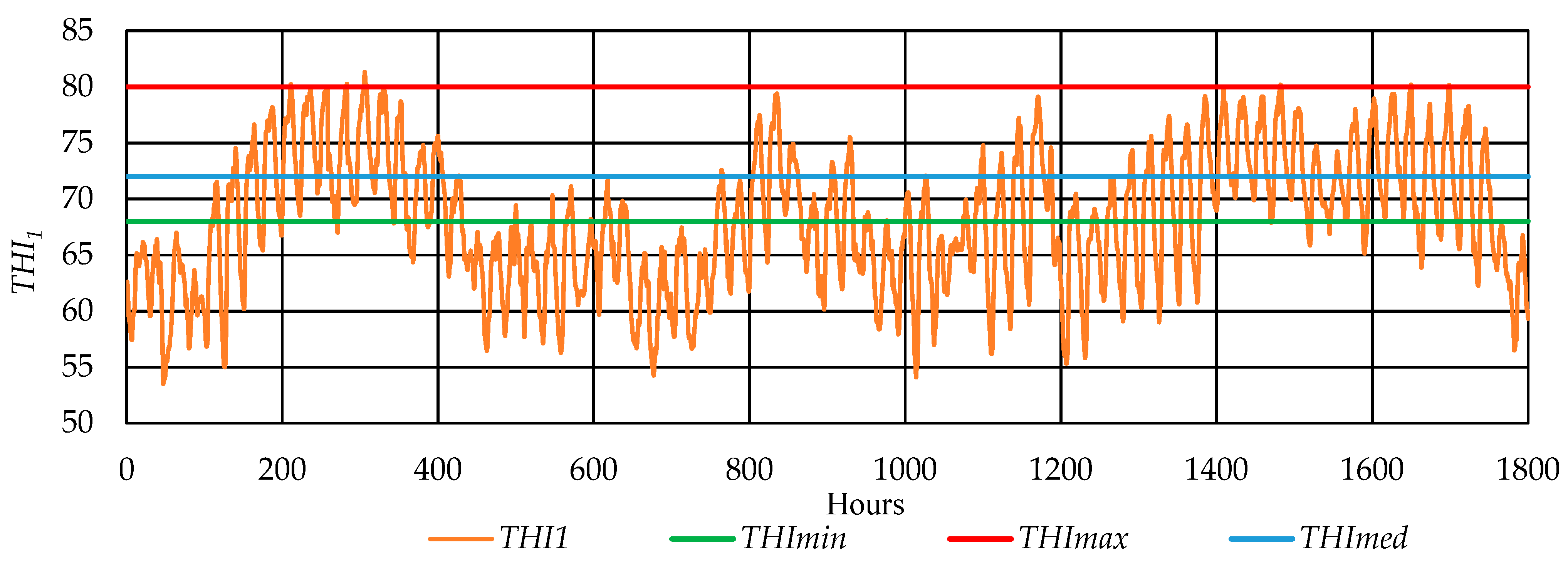
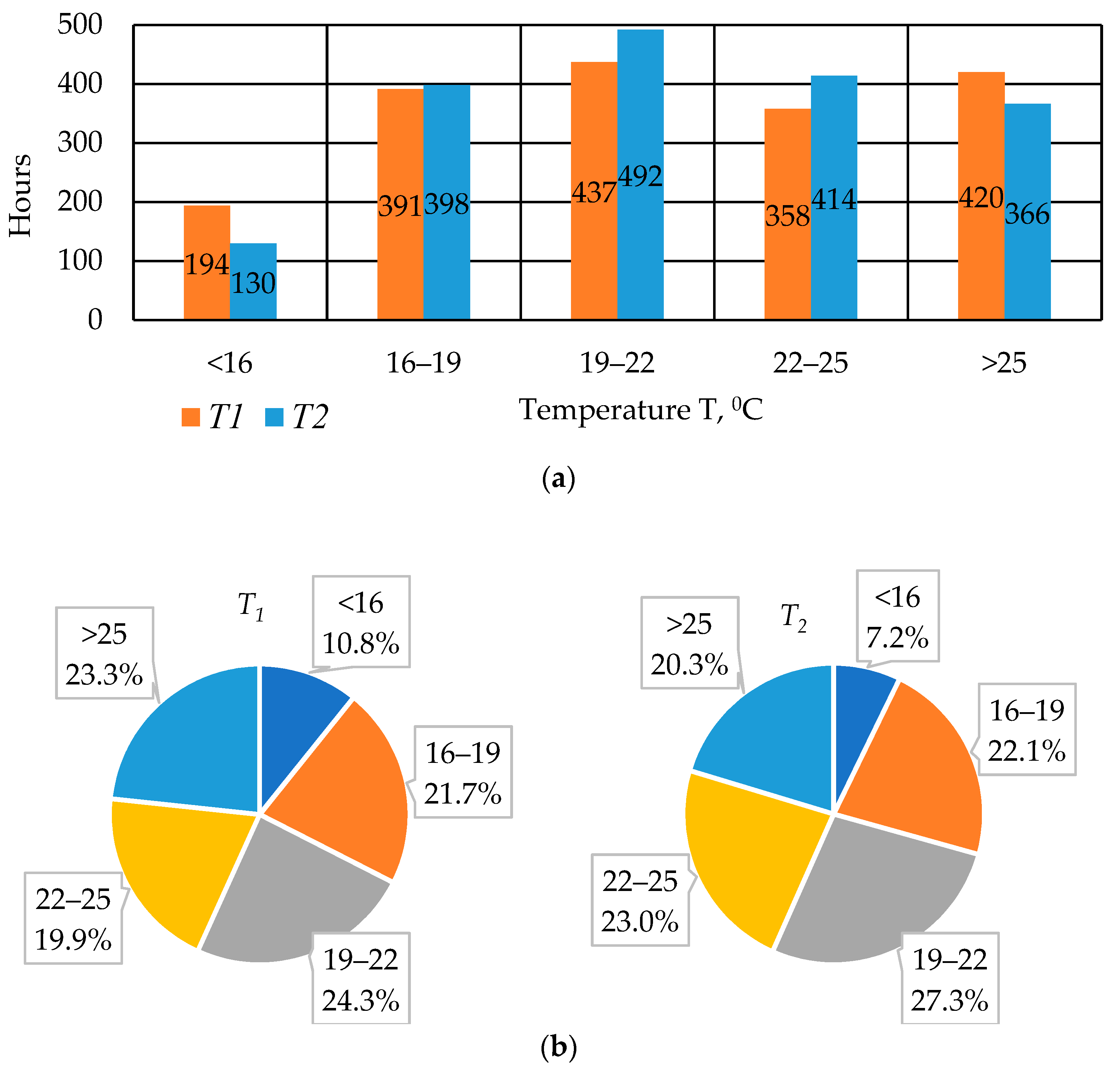
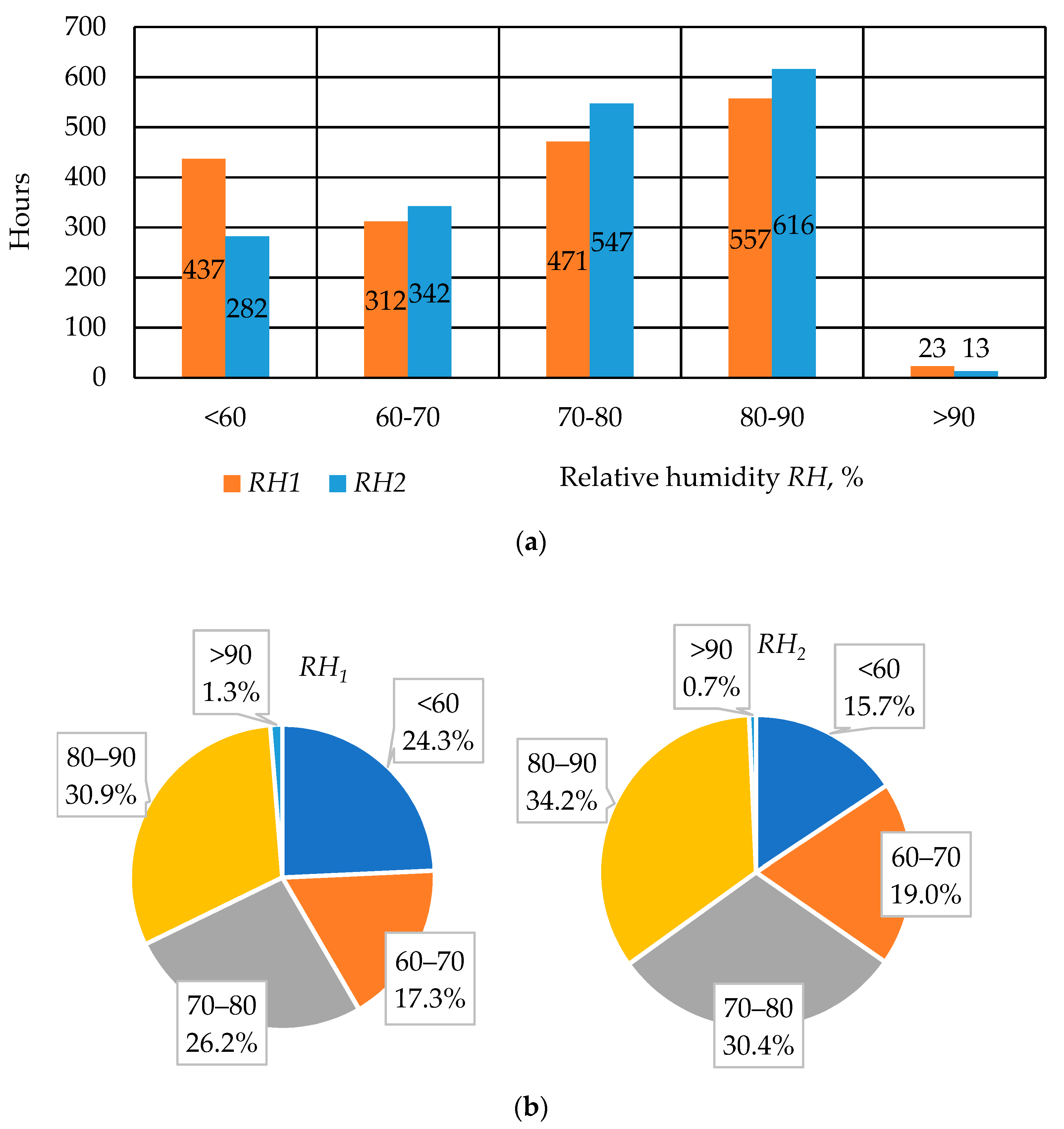


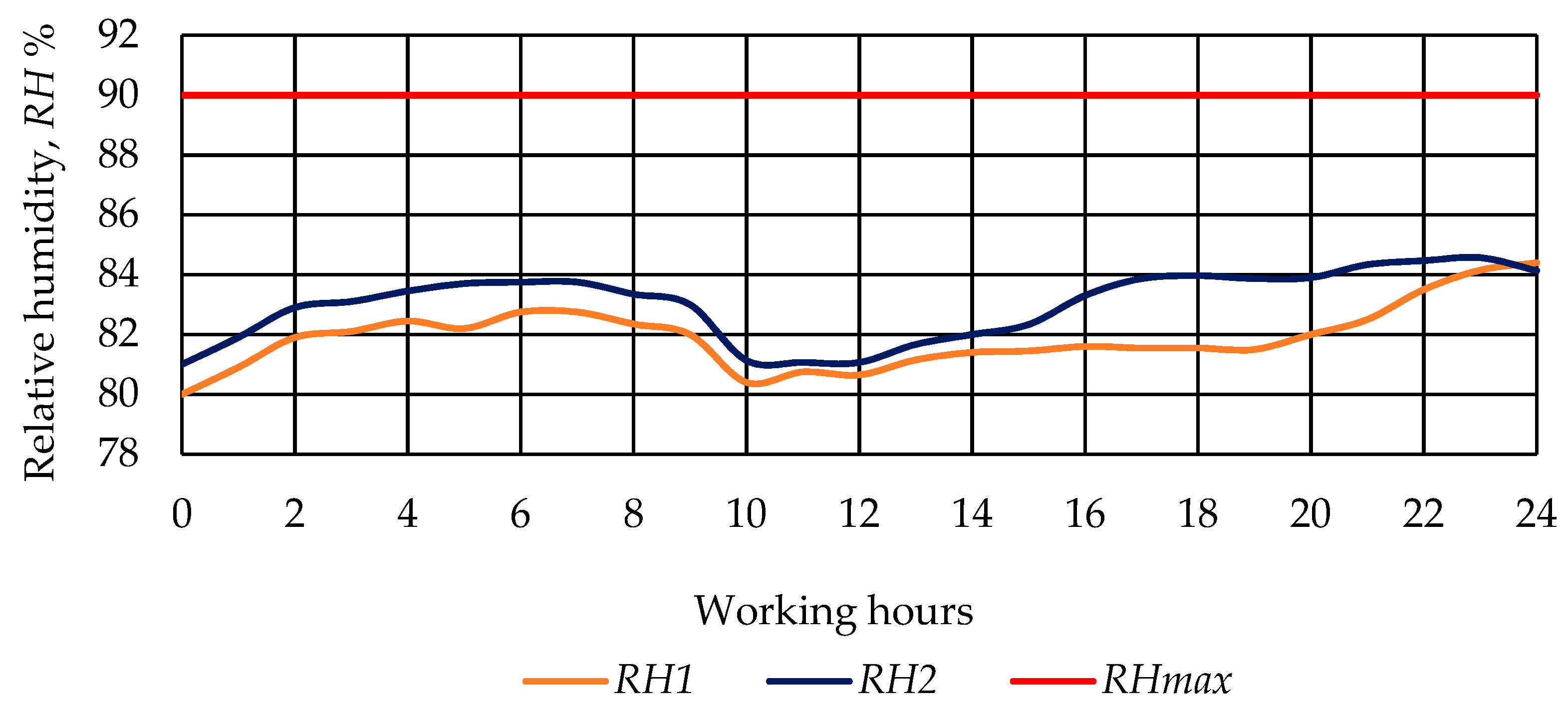

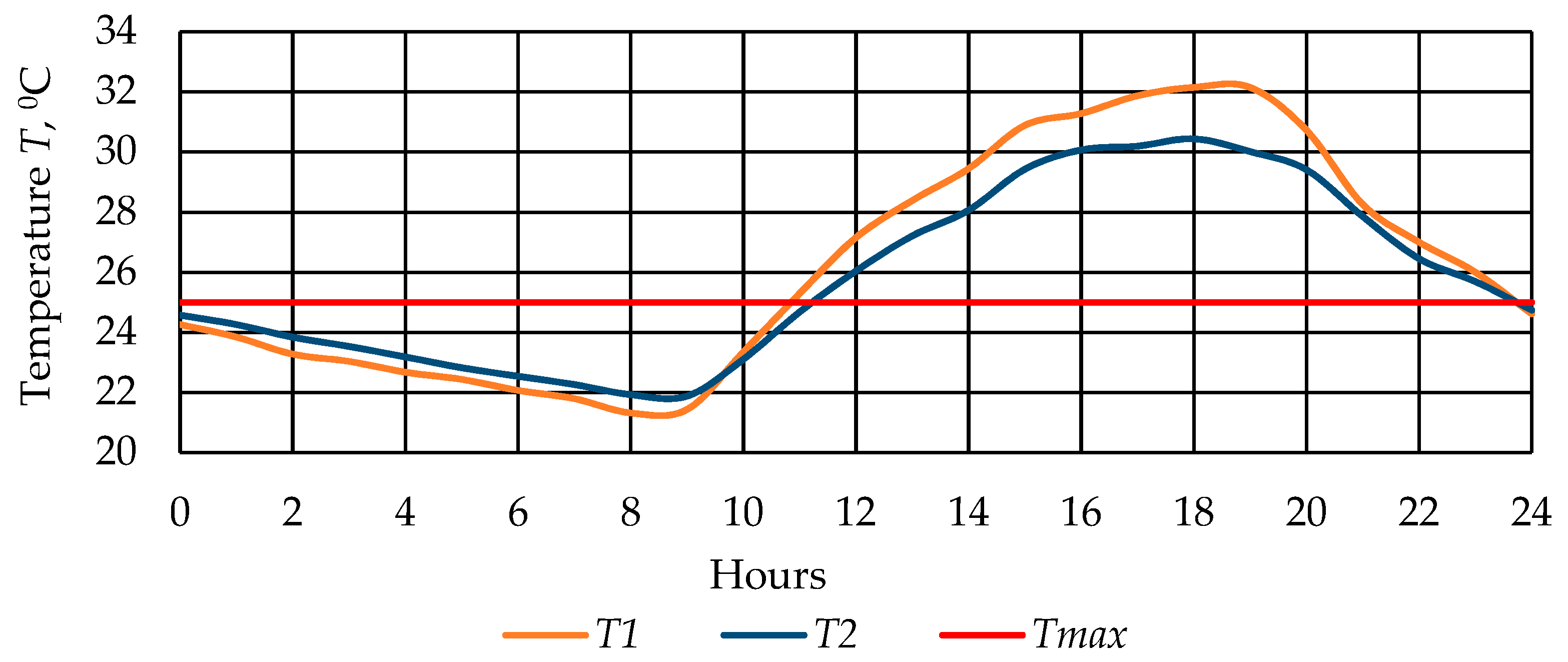

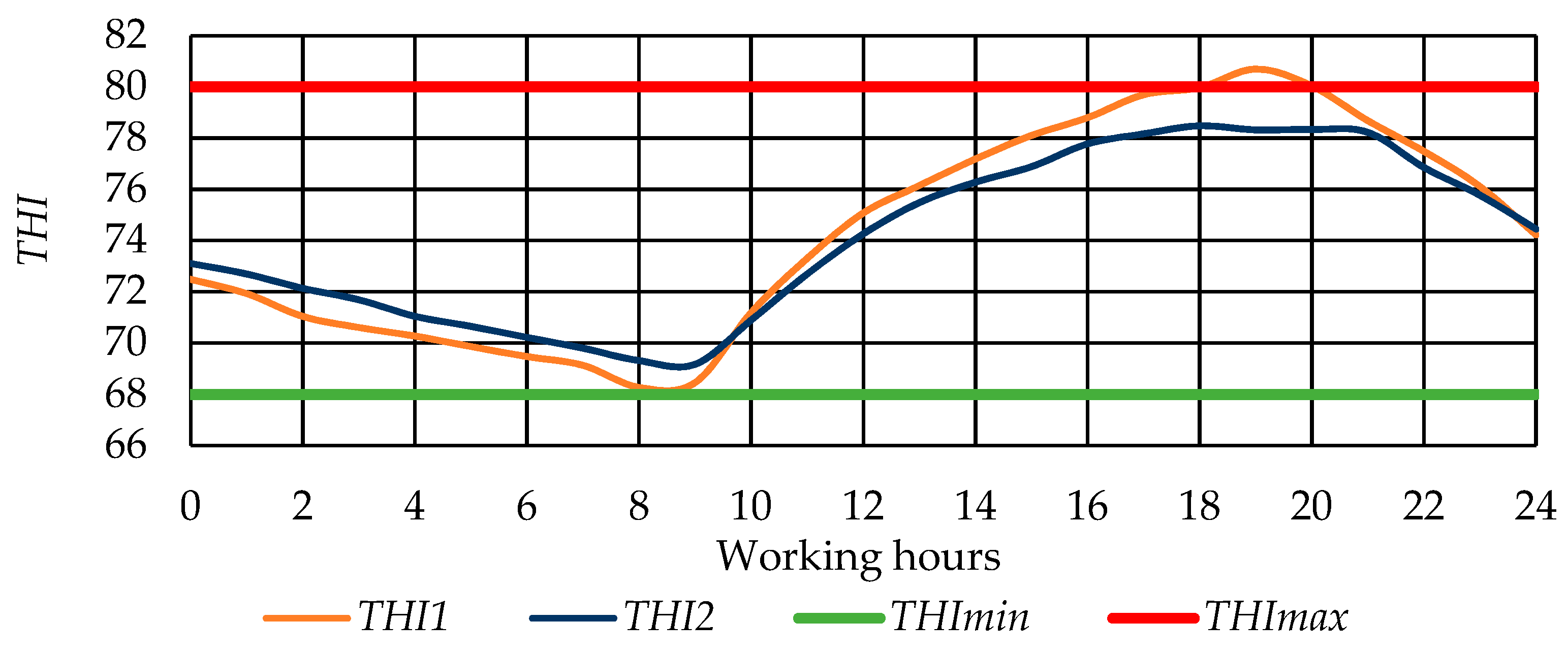


| T1, °C | Number of Hours | RH1, % | Number of Hours | THI1, °C | Number of Hours |
|---|---|---|---|---|---|
| <16 | 194 | <60 | 437 | <68 | 875 |
| 16–19 | 391 | 60–70 | 312 | 68–72 | 410 |
| 19–22 | 437 | 70–80 | 471 | 72–80 | 505 |
| 22–25 | 358 | 80–90 | 557 | >80 | 10 |
| >25 | 420 | >90 | 23 | - | - |
| Sum | 1800 | - | 1800 | - | 1800 |
| Value | T, °C | RH, °C | THI, °C | |||
|---|---|---|---|---|---|---|
| Outside | Inside | Outside | Inside | Outside | Inside | |
| Minimum | 11.91 | 12.40 | 32.45 | 37.67 | 53.55 | 54.65 |
| Maximum | 31.77 | 30.44 | 95.60 | 95.97 | 81.34 | 79.88 |
| Average | 21.51 | 21.46 | 70.74 | 73.08 | 68.21 | 68.48 |
| T2, °C | Number of Hours | % | N, kW (%) | Consumption of Electrical Energy | Water Consumption, м3 | |
|---|---|---|---|---|---|---|
| One Fan, kWh | 16 Fan, kWh | |||||
| <16 | 130 | 7.2 | 0 | 0.0 | 0 | 0 |
| 16–19 | 398 | 22.1 | 0.188 (25%) | 74.6 | 1194 | 305.7 |
| 19–22 | 492 | 27.3 | 0.375 (50%) | 184.5 | 2952 | 377.9 |
| 22–25 | 414 | 23.0 | 0.563 (75%) | 232.9 | 3726 | 318.0 |
| >25 | 366 | 20.3 | 0.750 (100%) | 274.5 | 4392 | 281.1 |
| Sum | 1800 | 100 | - | 766.5 | 12,264 | 1282.6 |
| THI2 | Number of Hours | % | N, kW (%) | Consumption of Electrical Energy | Water Consumption, м3 | |
|---|---|---|---|---|---|---|
| One Fan, kWh | 16 Fan. kWh | |||||
| <68 | 851 | 47.3 | 0 | 0 | 0 | 0.0 |
| 68–72 | 440 | 24.4 | 0.563 (75%) | 247.5 | 3960 | 337.9 |
| >72 | 509 | 28.3 | 0.750 (100%) | 381.75 | 6108 | 390.9 |
| Sum | 1800 | 100 | - | 629.25 | 10,068 | 728.8 |
Disclaimer/Publisher’s Note: The statements, opinions and data contained in all publications are solely those of the individual author(s) and contributor(s) and not of MDPI and/or the editor(s). MDPI and/or the editor(s) disclaim responsibility for any injury to people or property resulting from any ideas, methods, instructions or products referred to in the content. |
© 2023 by the authors. Licensee MDPI, Basel, Switzerland. This article is an open access article distributed under the terms and conditions of the Creative Commons Attribution (CC BY) license (https://creativecommons.org/licenses/by/4.0/).
Share and Cite
Bleizgys, R.; Čėsna, J.; Kukharets, S.; Medvedskyi, O.; Strelkauskaitė-Buivydienė, I.; Knoknerienė, I. Adiabatic Cooling System Working Process Investigation. Processes 2023, 11, 767. https://doi.org/10.3390/pr11030767
Bleizgys R, Čėsna J, Kukharets S, Medvedskyi O, Strelkauskaitė-Buivydienė I, Knoknerienė I. Adiabatic Cooling System Working Process Investigation. Processes. 2023; 11(3):767. https://doi.org/10.3390/pr11030767
Chicago/Turabian StyleBleizgys, Rolandas, Jonas Čėsna, Savelii Kukharets, Oleksandr Medvedskyi, Indrė Strelkauskaitė-Buivydienė, and Ieva Knoknerienė. 2023. "Adiabatic Cooling System Working Process Investigation" Processes 11, no. 3: 767. https://doi.org/10.3390/pr11030767
APA StyleBleizgys, R., Čėsna, J., Kukharets, S., Medvedskyi, O., Strelkauskaitė-Buivydienė, I., & Knoknerienė, I. (2023). Adiabatic Cooling System Working Process Investigation. Processes, 11(3), 767. https://doi.org/10.3390/pr11030767







